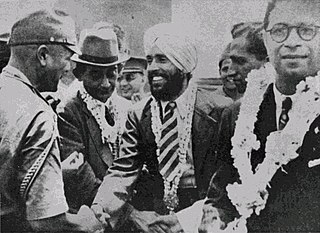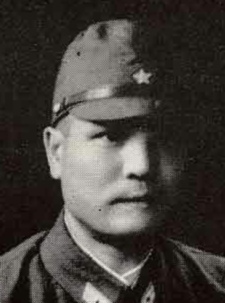Related Research Articles

The Indian National Army was a collaborationist armed unit of Indian collaborators that fought under the command of the Japanese Empire. It was founded by Mohan Singh in September 1942 in Southeast Asia during World War II.

Subhas Chandra Bose was an Indian nationalist whose defiance of British authority in India made him a hero among many Indians, but his wartime alliances with Nazi Germany and Imperial Japan left a legacy vexed by authoritarianism, anti-Semitism, and military failure. The honorific 'Netaji' was first applied to Bose in Germany in early 1942—by the Indian soldiers of the Indische Legion and by the German and Indian officials in the Special Bureau for India in Berlin. It is now used throughout India.

Indian nationalist leader Subhas Chandra Bose died on 18 August 1945 from third-degree burns sustained after the bomber in which he was being transported as a guest of Lieutenant General Tsunamasa Shidei of the Imperial Japanese Kwantung Army crashed upon take off from the airport in Taihoku, Japanese Formosa, now Taipei, Taiwan. The chief pilot, copilot, and General Shidei were instantly killed.

Mohan Singh was a British Indian Army officer, and later member of the Indian Independence Movement, best known for founding and leading the Indian National Army in South East Asia during World War II. Following Indian independence, Mohan Singh later served in public life as a Member of Parliament in the Rajya Sabha of the Indian Parliament.
The Indian Independence League was a political organisation operated from the 1920s to the 1940s to organise those living outside British India into seeking the removal of British colonial rule over the region. Founded by Indian nationalists, its activities were conducted in various parts of Southeast Asia. It included Indian expatriates, and later, Indian nationalists in-exile under Japanese occupation following Japan's successful Malayan Campaign during the first part of the Second World War. During the Japanese Occupation of Malaya, the Japanese encouraged Indians in Malaya to join the League.
The Bangkok Conference was a conference held on 23 June 1942 by Indian Nationalist groups and local Indian Independence leagues at Bangkok to proclaim the formation of the All-India Independence league. The conference further saw the adoption by the league of a thirty-four set resolution known as the Bangkok resolutions that attempted to define the role of the league in the Independence movement, relations with the nascent Indian National Army, and clarify the grounds and conditions for obtaining Japanese support for it. The resolution further attempted to clarify the relations of Japan and the Greater East Asia Co-Prosperity Sphere with a free India.

The Indian National Army trials was the British Indian trial by court-martial of a number of officers of the Indian National Army (INA) between November 1945 and May 1946, on various charges of treason, torture, murder and abetment to murder, during the Second World War.

Iwaichi Fujiwara was an officer in the Imperial Japanese Army in World War II, and later a lieutenant general in the post-war Japan Ground Self Defense Force.

Fujiwara kikan was a military intelligence operation established by the IGHQ in September 1941. The Unit was transferred to Bangkok at the end of that month and headed by Major Fujiwara Iwaichi, chief of intelligence of the 15th army. Its task was to contact the Indian independence movement, the overseas Chinese and the Malayan Sultans with the aim of encouraging friendship and cooperation with Japan. The unit was notable for its success in establishing cooperative ties between the Empire of Japan and the Indian independence movement, overseas Chinese and various Malay sultans.
The Bidadari Resolutions were set of resolutions adopted by the nascent Indian National Army in April 1942 that declared the formation of the INA and its aim to launch an armed struggle for Indian independence. The resolution was declared at a prisoner-of-war camp at the Bidadari in Singapore during Japanese occupation of the island.
The Iwakuro Kikan, or I Kikan, was an intelligence mission and liaison office for the Imperial Japanese Army and Indian National Army during the Second World War in the South-East Asian theatre. Headed by Colonel Hideo Iwakuro, it succeeded the F Kikan in liaising with the Indian Independence League and the Indian National Army under Captain Mohan Singh. After the revival of the Indian National Army under Subhas Chandra Bose, the Hikari Kikan replaced the I Kikan.
Giani Pritam Singh Dhillon was an Indian freedom fighter and Sikh missionary who, as a member of the Ghadar Party, was instrumental in the planning of the failed 1915 Ghadar conspiracy in the British Indian Army. Giani Pritam Singh Dhillon was a close friend of Gurbaksh Singh Dhillon, famous Sikh Indian independence movement leader and prominent member of the Indian National Army. He was also close associate of Subhas Chandra Bose. Pritam Singh is also remembered for reviving the same idea during World War II by seeking Japanese support in the establishment of what came to be the Indian National Army. Pritam Singh died in a plane crash in 1942.
K. P. Keshava Menon (1884?–?) was an Indian lawyer and a leading Indian independence activist from Kerala who was a key proponent of the formation of the Indian Independence League (IIL) and a lawyer for the Indian National Army (INA).
Jiffs was a slang term used by British Intelligence, and later the 14th Army, to denote soldiers of the Indian National Army after the failed First Arakan offensive of 1943. The term is derived from the acronym JIFC, short for Japanese-Indian fifth column. It came to be employed in a propaganda offensive in June 1943 within the British Indian Army as a part of the efforts to preserve the loyalty of the Indian troops at Manipur after suffering desertion and losses at Burma during the First Arakan Offensive. After the end of the war, the term "HIFFs" was also used for repatriated troops of the Indian Legion awaiting trial.
The First Indian National Army was the Indian National Army as it existed between February and December 1942. It was formed with Japanese aid and support after the Fall of Singapore and consisted of approximately 12,000 of the 40,000 Indian prisoners of war who were captured either during the Malayan campaign or surrendered at Singapore. It was formally proclaimed in April 1942 and declared the subordinate military wing of the Indian Independence League in June that year. The unit was formed by Mohan Singh. The unit was dissolved in December 1942 after apprehensions of Japanese motives with regards to the INA led to disagreements and distrust between Mohan Singh and INA leadership on one hand, and the League's leadership, most notably Rash Behari Bose. Later on, the leadership of the Indian National Army was handed to Subhas Chandra Bose. A large number of the INAs initial volunteers, however, later went on to join the INA in its second incarnation under Subhas Chandra Bose.
The Battles and Operations involving the Indian National Army during World War II were all fought in the South-East Asian theatre. These ranges from the earliest deployments of the INA's preceding units in espionage during Malayan Campaign in 1942, through the more substantial commitments during the Japanese Ha Go and U Go offensives in the Upper Burma and Manipur region, to the defensive battles during the Allied Burma campaign. The INA's brother unit in Europe, the Indische Legion did not see any substantial deployment, despite some engagement in Atlantic wall duties, special operations in Persia and Afghanistan, and later a small deployment in Italy. The INA was not considered a significant military threat. However, it was deemed as a significant strategic threat especially to the Indian Army as described by Wavell that it was a target of prime importance.
Prafulla Kumar Sen, also known as Swami Satyananda Puri, was an Indian revolutionary and philosopher. Puri, had in his youth taught Oriental philosophy at the University of Calcutta and later at Rabindranath Tagore's Visva-Bharati University at Santiniketan. Encouraged by Tagore, he arrived in Thailand in 1932, and in 1939, he founded the Thai-Bharat Lodge, a cultural forum. Arriving in Thailand, Puri was appointed a professor at the Chulalongkorn University, lecturing in ancient Indian and Thai languages, and is said to have mastered the Thai Language in six months and went on to translate a number of Indian philosophical works and biographies, including the Ramayana and biographies of Gandhi to Thai. His literary work eventually was more than twenty volumes.

Lieutenant General Harbaksh Singh, VrC was an Indian senior military officer. As the commander of the Western Command, Singh commanded the Indian Army and played a key role during the Indo-Pakistani War of 1965. For his role in the war, he was awarded the Padma Vibhushan in 1966.

Habib ur Rahman (1913–1978) was an army officer in the Indian National Army (INA) who was charged with "waging war against His Majesty the King Emperor". He served as Subhas Chandra Bose's chief of staff in Singapore, and accompanied Bose on his alleged last fatal flight from Taipei to Tokyo, sharing the last moments of his life. Rahman also played an important role in the First Kashmir War. Convinced that Maharaja Hari Singh was out to exterminate the Muslims of Jammu and Kashmir, he joined Major General Zaman Kiani, in launching a rebellion against the Maharaja from Gujrat in Pakistani Punjab. Rehman and his volunteer force launched an attack on the Bhimber town. But, the records of the 11th Cavalry of the Pakistan Army indicate that their efforts did not succeed, and eventually the Cavalry was responsible for conquering Bhimber.
The Indian National Army (INA) was a Japanese sponsored Indian military wing in Southeast Asia during the World War II, particularly active in Singapore, that was officially formed in April 1942 and disbanded in August 1945. It was formed with the help of the Japanese forces and was made up of roughly about 45 000 Indian prisoner of war (POWs) of British Indian Army, who were captured after the fall of Singapore on 15 February 1942. It was initially formed by Rash Behari Bose who headed it till April 1942 before handing the lead of INA over to Subhas Chandra Bose in 1943.
References
- Lebra, Joyce C. (1977), Japanese trained armies in South-East Asia, New York,Columbia University Press, ISBN 0-231-03995-6 .
- Green, L.C. (1948), The Indian National Army Trials. The Modern Law Review, Vol. 11, No. 1. (Jan., 1948), pp. 47-69., London, Blackwell..
- Fay, Peter W. (1993), The Forgotten Army: India's Armed Struggle for Independence, 1942-1945., Ann Arbor, University of Michigan Press., ISBN 0-472-08342-2 .
